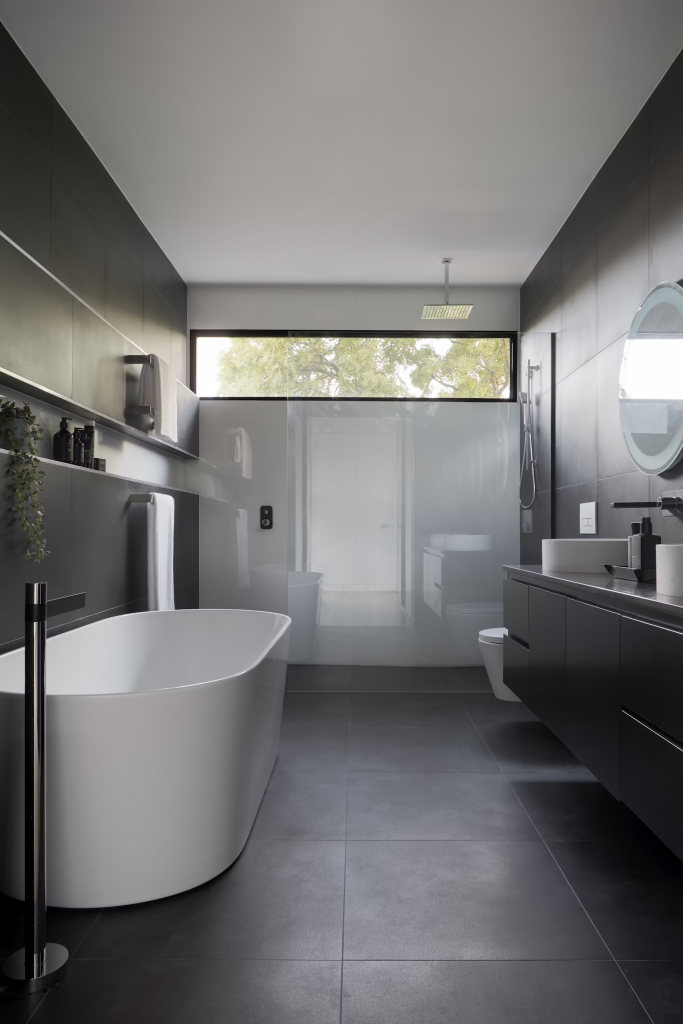Renovating a bathroom can be one of the most rewarding home improvement projects. Whether you’re looking to update an outdated style, improve functionality, or increase the value of your home, a well-executed bathroom renovation can achieve all these goals and more. However, diving into a renovation can also be daunting, especially if you’re not sure where to begin.

To ensure your bathroom renovation is a success, it’s crucial to start with a well-thought-out plan. This article will guide you through the steps to kickstart your bathroom renovation, from initial planning to execution, ensuring a smooth and satisfying process.
How To Start A Bathroom Renovation?
Starting a bathroom renovation can feel overwhelming, but breaking it down into manageable steps can make the process more straightforward. Here’s how to get started:
Define Your Goals And Budget
Before diving into the renovation, it’s essential to clearly define what you want to achieve. Are you looking to completely overhaul your bathroom, or are you simply updating a few key elements like the shower and vanity?
Perhaps your goal is to create a spa-like retreat or to make your bathroom more functional for a growing family. Whatever your objectives, having a clear vision will help guide all your decisions moving forward.
Once you have defined your goals, it’s time to establish a budget. Your budget will determine the scope of your project and the types of materials you can use. It’s crucial to be realistic about what you can afford and to include a contingency fund for unexpected expenses, which are common in renovation projects.
Research the costs of materials, labour, and permits to get a comprehensive understanding of your potential expenses. Allocating your budget wisely can help avoid financial stress and ensure a smoother renovation process.
Plan Your Layout And Design
After setting your goals and budget, the next step is to plan your bathroom’s layout and design. This involves deciding on the placement of key features such as the toilet, shower, bathtub, and vanity.
If you’re working within an existing footprint and not moving major plumbing fixtures, your layout options may be more limited. However, if you’re looking to reconfigure the space entirely, this is your chance to optimize the layout for both function and aesthetics.
Consider the following elements when planning your layout:
- Flow and Functionality: Ensure that the bathroom is easy to navigate and that there’s enough space for all fixtures and storage needs. For example, the toilet should not be the first thing you see when you open the bathroom door. The shower and tub should have adequate space, and the vanity should provide enough counter space and storage for your needs.
- Lighting: Good lighting is crucial in a bathroom. Plan for a mix of ambient, task, and accent lighting to create a well-lit and inviting space. Think about incorporating natural light if possible, such as through windows or skylights.
- Ventilation: Proper ventilation is essential in a bathroom to prevent mould and mildew. Make sure your design includes adequate ventilation options, such as a vent fan or windows.
- Once the layout is set, you can start thinking about design elements such as colour schemes, tiles, fixtures, and finishes. Create a mood board or use online design tools to visualize your choices and see how they come together.
Choose Materials And Fixtures
With your design and layout in place, it’s time to choose the materials and fixtures for your renovation. This includes everything from tiles and countertops to faucets and lighting fixtures. The materials and fixtures you choose will significantly impact the overall look, feel, and functionality of your bathroom, so it’s important to make thoughtful choices.
Here are some tips for selecting materials and fixtures:
- Durability: Bathrooms are high-traffic areas that are exposed to moisture and fluctuating temperatures. Choose materials that are durable and can withstand these conditions. For example, porcelain and ceramic tiles are popular choices for bathroom floors and walls because they are water-resistant and easy to clean.
- Style: Your bathroom should reflect your style while also complementing the rest of your home. Consider the overall aesthetic you want to achieve, whether it’s modern, traditional, minimalist, or something else, and choose materials and fixtures that align with that vision.
- Maintenance: Some materials require more maintenance than others. For example, natural stone countertops are beautiful but require regular sealing to protect against stains. If you prefer low-maintenance options, consider materials like quartz for countertops or porcelain tiles for flooring.
- Eco-Friendly Options: If sustainability is important to you, consider eco-friendly materials and fixtures. Look for water-saving faucets and showerheads, low-flow toilets, and recycled or sustainable materials.
Once you’ve chosen your materials and fixtures, order them in advance to avoid delays in the renovation process. It’s also a good idea to order extra materials, especially tiles, to account for any mistakes or future repairs.
Hiring Professionals Vs. DIY
One of the most significant decisions you’ll face during a bathroom renovation is whether to hire professionals or tackle some or all of the work yourself. There are pros and cons to both options, and the right choice depends on your skill level, budget, and the scope of your project.
Hiring Professionals
Hiring professionals, such as contractors, plumbers, electricians, and designers, can provide peace of mind and ensure a high-quality result. Professionals have the experience and expertise to handle all aspects of the renovation, from demolition to installation, and can help you avoid costly mistakes.
They are also familiar with local building codes and regulations, which can be particularly important when it comes to plumbing and electrical work.
Working with professionals can be more expensive than doing it yourself, but it can also save you time and stress. If you have a busy schedule or are not confident in your DIY skills, hiring professionals may be the best option.
DIY Approach
If you’re on a tight budget or enjoy hands-on projects, taking a DIY approach to some or all of your bathroom renovation can be a rewarding experience. However, it’s important to be realistic about your abilities and the time you can dedicate to the project. Some tasks, like painting or installing fixtures, may be manageable for a DIYer, while others, like plumbing and electrical work, are best left to professionals.
If you decide to go the DIY route, make sure to do your research and invest in quality tools and materials. There are plenty of online resources, tutorials, and workshops available to help you learn the necessary skills. Keep in mind that even with a DIY approach, you may still need to hire professionals for certain aspects of the renovation, such as electrical or plumbing work.
Common Bathroom Renovation Mistakes To Avoid
A successful bathroom renovation requires careful planning and execution. To help you avoid common pitfalls, here are some mistakes to watch out for:
Skimping on Quality
- It can be tempting to cut costs by choosing cheaper materials or fixtures, but this can lead to problems down the road. Low-quality materials may not hold up well in a bathroom’s moist environment, leading to costly repairs or replacements. Invest in quality materials and fixtures that will stand the test of time and provide a better return on investment.
Ignoring Storage Needs
- Storage is often overlooked in bathroom renovations, but it’s a crucial element for keeping the space organized and functional. Make sure to incorporate adequate storage solutions, such as cabinets, shelves, and vanity drawers, to accommodate all your needs.
Overlooking Ventilation
- Proper ventilation is essential in a bathroom to prevent mould, mildew, and moisture damage. Ensure that your renovation includes adequate ventilation, such as a high-quality exhaust fan, to keep the space dry and healthy.
Failing to Plan for the Unexpected
- Even with careful planning, unexpected issues can arise during a renovation. It’s important to have a contingency plan and budget to address any surprises that may come up, such as hidden water damage or outdated plumbing that needs to be replaced.
Conclusion
A bathroom renovation can transform one of the most used rooms in your home into a functional and stylish space. By starting with clear goals, a realistic budget, and a well-thought-out plan, you can ensure a smooth renovation process. Whether you decide to hire professionals or take on some DIY tasks, remember to prioritize quality, functionality, and proper planning.
By avoiding common mistakes and making thoughtful choices, your new bathroom can become a beautiful and valuable addition to your home. With these steps in mind, you’re now ready to start your bathroom renovation journey with confidence.
In search of more information? Click and visit bathroom renovations malvern, today!

